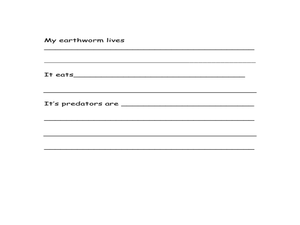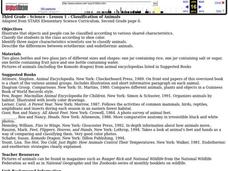Curated OER
Biomes -- Part II
Students use the internet to gather information on the biomes of the world. They identify the climate and unique characteristics of each biome along with any threat to them. They create their own campaign to preserve wildlife.
Curated OER
Amazon Rainforest
Seventh graders complete a simulation in which they travel through the Amazon rainforest. Using their map skills, they determine the best route and where to see specific plants and animals. They develop their own database to organize...
Curated OER
Food Webs
Students recognize interdependence in a food web by using yarn and notecards to create a food web and discussing what would happen if one of the organisms from a certain trophic level is removed.
Curated OER
Prairies
Students identify the basic characteristics of the prairie ecosystem, and several commonly known prairie species. They create a classroom mural of a prairie ecosystem; and create reports about what they have found out.
Curated OER
Desert Biome
Students examine the vocabulary of desert animals and observe pictures of the animals as they name them. As a class, students compare and contrast the characteristics of desert animals. Using a specified website, students match...
Curated OER
California Biodiversity
High schoolers examine several maps of California exhibiting features such as precipitation, topography, and vegetation. They look for patterns that might be the source of or influence biodiversity in different regions. They pay...
Curated OER
VERTEBRATES
Seventh graders describe the main characteristics of warm-blooded vertebrate animals. They compare and contrast the two different groups of warm-blooded vertebrate animals by looking at external, reproductive, and growth characteristics.
Curated OER
Night Hike
Learners explore Upham Woods at night and investigate about the special adaptations of nocturnal animals. They identify three nocturnal animals and how they are adapted to the night. Students explain what night vision is and how it works.
Curated OER
Digging Into Science: Final Analysis
In this archeological excavation worksheet, students complete 9 short answer questions based on a simulated archeological activity they performed in a small group.
Curated OER
Protists
In this protists worksheet, students will read about the different kinds of protists including protozoans, algae, and molds. Students will then complete 2 short answer questions and 1 true or false question.
Curated OER
Digging Up Dinosaurs
In this dinosaurs learning exercise, students read a nonfiction book about dinosaurs and then answer 6 comprehension questions and present an oral presentation.
Curated OER
Biodiversity Memory Match Up
Students are introduced to the animals of Asia. In this biodiversity lesson, students use interactive maps to identify animals from Asia, then play a memory game to reinforce the information.
Curated OER
Oil + Water + Wildlife = A Real Mess
Students conduct an experiment. In this environmental protection lesson, students explore how oil spills affect living organisms in an ecosystem. Students work in groups to complete a lab activity and then discuss their findings.
Curated OER
Convening, Creating, and Conventioneering
Students study coelenterates. In this science lesson, students author a story regarding the life cycle of coelenterates following an in depth study of the creatures.
Curated OER
Are There Too Many Elk?
Students study elk populations in Arizona. In this data lesson students read an article on monitoring elk populations, analyze data and make management recommendations.
Curated OER
Are There Too Many Elk?
Students use information about elk populations in Arizona to make recommendations about population management. In this ecology lesson, students discover the problems associated with having a heard of elk that is too large. After...
Curated OER
My Owl Babies Miss Momma
Students investigate the relationship between children and parents by reading a book about owls. In this story analysis lesson, students read the book Owl Babies and participate in a role play based on one of the characters. Students...
Curated OER
North American Butterflies and Moths of Fields, Meadows, and Fencerows
In this North American butterflies and moths instructional activity, students click on the links in the questions about North American butterflies and moths of fields, meadows, and fencerows to find the answers to the questions and then...
Curated OER
Mammals
In this mammals worksheet, students click on the links in the questions about mammals to find the answers to the questions and then come back and answer the questions. Students answer 8 questions total.
Curated OER
The Lesson: Species Under Threat
Learners consider the plight of endangered species. In this global studies instructional activity, students research selected websites about endangered animals and identify global issues that contribute to their demise.
Curated OER
Earthworms and Making a Wormery
Students explore the environment by researching insects. In this earthworm instructional activity, students utilize soil and plexiglass to build a see through wormery in which students can observe the worms at work. Students identify the...
Curated OER
The Invisible Zoo
Learners differentiate cold and warm-blooded animals using infrared images. In this physics lesson, students compare the images formed by infrared and visible light. They explain how scientists use infrared technology to study animals.
Curated OER
Polar Bears in Captivity
In this polar bears worksheet, students answer short answer questions about how polar bear's needs are met at the zoo. Students complete 6 questions.
Curated OER
Classification of Animals
Third graders practice classiyfying items and identify three major characteristics scientists use to classify animals. They describe the differences between ectothermic and endothermic animals.
Other popular searches
- Animal Habitats
- Powerpoint Animal Habitats
- Animal Habitats in Georgia
- Animal Habitats Math Games
- Animal Habitat Diorama
- Animal Habitats Kindergarten
- Plant and Animal Habitats
- Animal Winter Habitats
- Lessons on Animal Habitats
- Animal Habitats Adaptation
- Math Animal Habitats
- Animal Habitats and Zoos

























